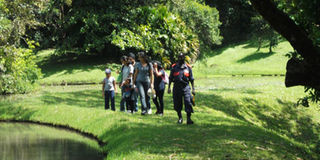Foray at Homa Lime

A Walk by the dam at Homa Lime. Photo/RUPI MANGAT
What you need to know:
- Rupi Mangat finds a beautiful and tranquil farm full of things to do, at Koru.
It is not every day that I consider a farm interesting enough to include on my sightseeing itinerary, but I after visiting Hola Lime and liking it, I am determined to sample what other farms have to offer.
There is so much to see and do, from the workings of a lime factory and life on a sugar cane farm, to the making of jaggery. One can also make forays into the forest or even bird-watch, which is exactly what we start with.
A colobus monkey rents the air with its signature screech and slips into the forest before l can see it. We scan the riverine glade for it but all we hear is its call. I wish l could swing through the forest like an arboreal monkey.
These two species — the Guereza and the Angolan —are on the list of endangered wildlife because of habitat loss, and if they are to survive, virgin forests like the one at Homa Lime must be saved. The presence of these endangered monkeys informed the gazetting of the forest to protect their habitat.
“I resigned from the Kenya African Rifles (KAR), to come back here,” recalls John Norman Brooks, the grand old man of Koru, who I meet before driving off to the forested hills on the farm. He is remembering the 1940s, when he was a lad and had to help his father run the family coffee farm.
The young Brooks realised that it would never produce enough to sustain the family. “So l got a job with Homa Lime Company and stayed.”
For Sh300 a month, Brooks worked his way up to become a farm manager — and with every salary increment he got, he bought shares and 40 years later he became the farm owner. Intrigued, I ask him about the lime on the land. “It was Dr Gordon who first made lime in Kenya.” The first lime was produced in Homa Bay (about 100 kilometres away on the shores of Lake Victoria).
At that point the farm at Koru grew the trees that were used as firewood for the lime kilns but with time the company’s management realised that it too was sitting on lime deposits. “We began to buy other farms in the area till we had possession of all the limestone. Gordon had predicted that one day there would be a demand for it.”
Fulfilling excursion
The lime is used in the sugar cane factory as a chemical to clarify cane juice and adjust its PH. It is also used in agriculture to improve the PH of the soil, as well as in construction for mortar and plaster.
Driving past the lime quarry and the jaggery factory, and through the sugar cane plantations, our guide brings us to a halt at the base of a hill covered in indigenous forest, where a troop of baboons plays.
The children are excited — it is their day out — and we begin the hike up the hill and down again when suddenly Maya catches sight of a beautiful green snake swimming in the cattle trough. Sensing company, it slips out of the water and into the dense undergrowth of the forest.
A few minutes away from Homa Lime, past the earth-coloured waters of River Nyando on its way to Lake Victoria, we drive up the hill in Fort Ternan, where the fossil site under the National Museums of Kenya is. The few fossils under the hut serve as an on-site showcase.
Several million years ago, our human-like ancestors swung around the forest trees and animals now long extinct, like the four-tusked elephant and rhinos. The hillside fossil site at Fort Ternan has revealed evidence of such finds but it is not open to the public without prior permission from the National Museums of Kenya.




